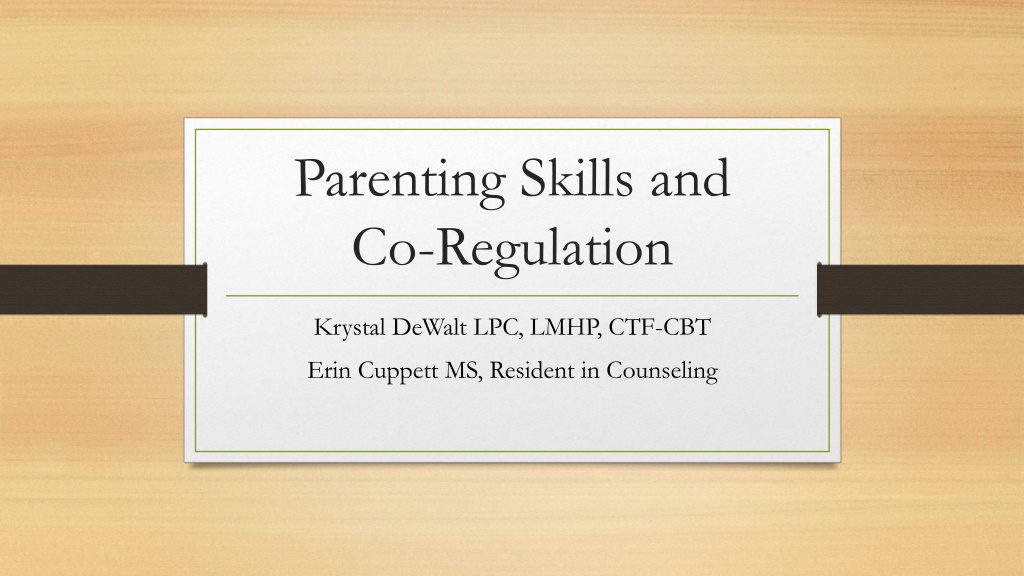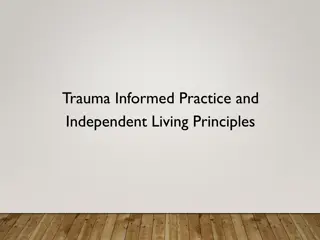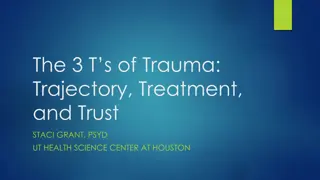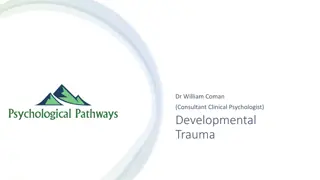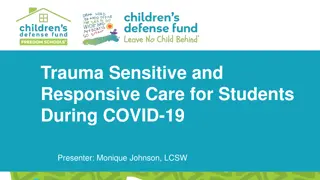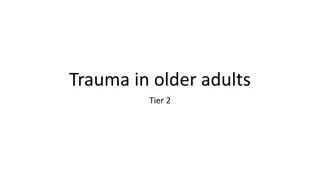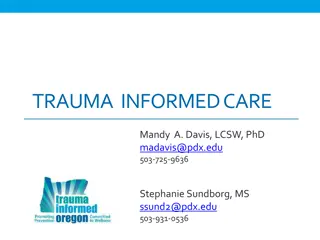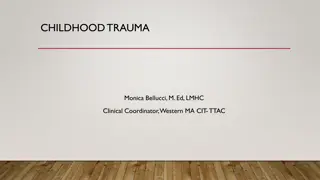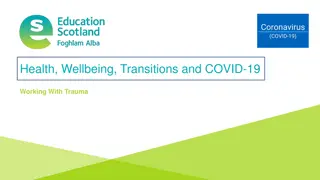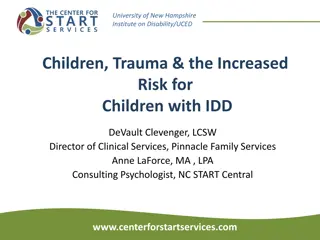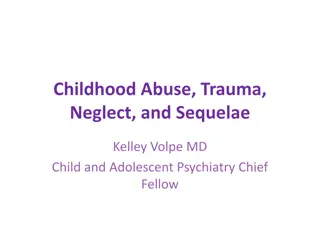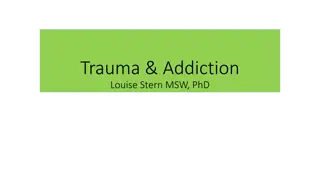Understanding the Impact of Trauma on Children
Trauma can significantly affect children's emotional, behavioral, and developmental well-being. Research shows that a high number of children experience traumatic events, leading to various challenges. Younger children are particularly vulnerable to the effects of trauma, depending on how their parents respond. Traumatic memories are stored differently in the brain, impacting how children react to triggers. Recognizing these effects is crucial in supporting children who have experienced trauma.
Download Presentation

Please find below an Image/Link to download the presentation.
The content on the website is provided AS IS for your information and personal use only. It may not be sold, licensed, or shared on other websites without obtaining consent from the author. Download presentation by click this link. If you encounter any issues during the download, it is possible that the publisher has removed the file from their server.
E N D
Presentation Transcript
Parenting Skills and Co-Regulation Krystal DeWalt LPC, LMHP, CTF-CBT Erin Cuppett MS, Resident in Counseling
Number of Children Affected Research shows that up to 1 out of 4 children and adolescents have experienced at least 1 traumatic event by the time they are 16 years old. 4 out of 10 U.S. children report witnessing violence; 8% report a lifetime prevalence of sexual assault, and 17% report having been physically assaulted. Nearly 80% of abused children face at least one mental health challenge by age 21.
Trauma Across Development For short-lived trauma, younger children are more dependent on their parents reaction to that trauma than older children. If the parents cope well, most younger children do not develop serious or long-lasting trauma symptoms Ongoing traumas that start early in life have the potential to dramatically alter the trajectory of young children s development more than chronic traumas that begin later in adolescence.
Trauma and the Brain Traumatic memories are encoded differently in the brain than other memories. Therefore, some children will experience the same physiological (senses) and/or psychological response to trauma reminders as they did to the event itself. A fear response can become generalized so that people, places or events that remind the child of the trauma in any way can cause the same response as the actual event, even if an outsider cannot identify any relation to that event. All large males cause a reaction in a young child who has experienced physical abuse at the hands of their father. Children who have been physically abused pick up on angry faces much faster than other children
How Trauma Affects Emotions Affective (or emotion regulation) symptoms include: Fear Depression Anger And affective dysregulation (or frequent mood changes)
How Trauma Affects Behavior When a child experiences a traumatic event, their natural, protective responses kick in: (fight, flight, or freeze) The child can then have these same physiological and behavioral responses to trauma reminders Children develop behaviors in an effort to avoid painful feelings or reminders of the traumatic experience Some behaviors develop as a result of traumatic bonding in which the child has learned maladaptive behaviors that were modeled in abusive or violent homes and communities
Function of the Behavior In order to modify behaviors effectively, we have to determine what the function of the behavior is. Attention seeking Escape/avoidance Access to a preferred item Sensory stimulation
How Trauma Affects Parents Parenting is affected by a number of factors following a traumatic event: The parent s own traumatic stress or grief reactions Generational Trauma The parent s view on how the child should react to a traumatic event. The parent s desire to not inflict any more pain on the child, resulting in overly permissive parenting Other misguided attempts to lessen the child s suffering Parents may feel: Guilt Shame Anger Or a number of other emotions related to the child s trauma
Parent Involvement in Treatment Parents are a central therapeutic agent for change! The parent can be the child s strongest source of healing Goal is to establish parent as the person the child turns to for help in times of trouble Parents will also receive support in processing through their own experiences related to the trauma.
Why are Positive Parenting Skills Important? Even the most competent parent can have difficulty with parenting effectively in the face of a child s severely traumatic life event. The challenge of parenting adds additional barriers to the healing process: Maintaining normal routines and consistency in rules and expectations in the face of stress promotes adaptive functioning in children and adults. This is especially true when children respond to traumatization with aggression, angry outbursts and other negative behaviors.
Praise The reality is that most parents spend more time correcting or criticizing their children than they do praising them for things they are doing well. Parents also attend to negative behaviors more frequently because they get your attention more often than positive behaviors. Example: The child plays in their room independently for 15 minutes while you are cooking dinner but then comes out to tell you that they are hungry and whines that dinner is not ready. Most parents will have attended to the whining rather than taking a minute to go and tell the child how much they appreciate the 15 minutes that they have been in their room, playing quietly. Finding opportunities to praise the child will strengthen the relationship, build trust and facilitate further bonding.
Effective Praise Praise a specific behavior Give some examples of generic vs. specific praise. Provide praise as soon as possible after the behavior has occurred. Be consistent and praise the behavior each time it occurs. Do not qualify your praise. (i.e. I m so glad you cleaned your room today like I asked. Why can t you do that every time? ) Provide praise with the same level of intensity that you would provide criticism. Don t praise faintly but criticize loudly. If a child is attempting to gain focused attention from the parent and can only get this through negative behaviors, the negative behaviors will increase. Be genuine
Challenges with Praise Parent has difficulty identifying any positive behaviors Childhood PTSD can include a seemingly constant irritable mood and repeated angry outbursts. Parents can become focused on these behaviors and they can occur so frequently that the parent has difficulty finding positive behaviors to praise. Catch the child being good Or at least catch the child when they are not showing any specifically negative behaviors. It s so nice to just sit here in the car with you calmly.
Challenges with Praise, Cont. What if the child responds in a sullen tone or with a rude or sarcastic remark? Don t engage in a power struggle Don t take it personally Decode the behavior (What is the function?) What is the child/teen trying to express? Low self-esteem, feelings of turmoil in the relationship, frustration with something else Use this time to practice both active listening and selective listening skills
Active Listening Active Listening is a communication skill that is used to identify not only what is being said, but any underlying messages that are being communication through body language, tone of voice, and overall attitude. Active listening helps children to feel valued, connected, validated and understood It builds trust and credibility Helps to clarify a child s thoughts and feelings Helps to avoid conflict and misunderstandings Makes is more likely that a child will talk, express themselves and seek your guidance in the future
Active Listening 1. Give the child your full attention 2. Maintain eye contact and if possible (and safe), get down on their level 3. Listen carefully to what is being said 4. Use encouragers to show that you are interested ( I see, uh huh, mmm, etc.) 5. Reflect back the feeling (this demonstrates empathy and helps with clarification) 6. Don t be afraid of silence 7. Ask open-ended questions 8. Summarize 9. Make Non-judgmental statements https://youtu.be4VobVB4CTU
Selective Attention What is selective attention? When a parent consciously makes a decision to not react to certain negative behaviors the child exhibits. The parent must remain calm with a neutral facial expression so as to not give the child any reaction they may be looking for. Remember to ignore the behavior, not the child! The moment the child begins behaving positively, the parent immediately provides attention and praise for positive behavior. This is an excellent opportunity to provide instruction and discussion about the incident.
Extinction Burst A brief escalation in a behavioral outburst as a reaction to the adult no longer giving this behavior the attention that the child desires. In other words, the child will increase the frequency and intensity of the behavior in an attempt to gain attention until they realize that their efforts are not working. This is a good sign!!! It means selective attention is working! Keep going! If the parent gives attention to the behavior as it gets more intense, then the child learns that they have to be really loud and disruptive to get attention and this will make the behavior worse! A child taps a pencil on the table to annoy their parent. The parent ignores this and the child taps louder and louder. Then the child gets two pencils and taps them both even louder.
Behaviors That Should Be Ignored Temper tantrums Angry verbalizations towards the parent Making faces, eye rolling or smirking Mocking, taunting or mimicking the parent Comments meant to provoke a reaction or be intentionally annoying
Behaviors That Should Not Be Ignored Overtly dangerous behaviors Physical aggression Property destruction that can result in harm to themselves or someone else Throwing objects that can harm themselves or someone else Climbing onto furniture (depending on age and type of furniture) Running away
Time-Out The use of time-out has 2 specific purposes: 1. To interrupt the child s negative behavior and give them an opportunity to regain control 2. To ensure that the child does not gain attention for this behavior.
Effective Time-Out Procedures 1. Locate a quiet, non-stimulating room or area of the home. 2. Explain the time-out procedure before the first time it is used. Explain that if the child engages in a particular behavior, they will be placed in time out Time out will last 1 minute for every year the child is old (6 minutes for a 6-year-old) 3. When the child begins engaging in the behavior, calmly ask them to engage in a safe behavior Be specific! Say, Use calm feet, or Nice voice. Avoid giving attention to the behavior by saying, stop yelling! or stop kicking me! 4. If the child does not stop the behavior, TELL them to go to time out or escort the child there if necessary. 5. Set the timer to begin once the child has stopped yelling, banging, etc. 6. Following the time-out, immediately begin interacting and engaging in positive praise for desired behavior.
Challenges with Time Out What if the child refuses to go to time out? Make sure that the parent is TELLING the child to go to time out and not ASKING the child to go. If the parent can safely do so, escort the child to the time out area If the parent is not able to escort the child, the parent can leave the room, which deprives the child from the desired attention. What if behavior problems are so severe that the parent cannot manage them alone? Additional services may need to be in place for children with severe and/or dangerous behavior problems. Examples include Family therapy (Parent Child Interaction Therapy is an evidenced based model), Intensive In Home Therapy, outpatient therapy, psychiatric services and even residential treatment depending on the level of severity and potential harm to the child and family.
Behavior Charts Useful for decreasing undesired behaviors and increasing desired behavior. Guidelines for using Behavior Charts Choose only 1 behavior at a time to target. Make the expectations clear so that the child knows specifically how to obtain a star/sticker. Ask the child to participate in decisions about what the reward will be Give rewards consistently and frequently Rewards should be faded once the child demonstrates mastery or close to mastery of the target behavior.
Self-Regulation Self-regulation is the ability for a person to effectively regulate their emotions (maintain, change, inhibit and increase emotional responsiveness and reactions) through a series of regulatory processes: 1. How we feel emotions 2. How we pay attention to emotions 3. How we think about these feelings 4. How we behave Self-regulation is developed through co-regulation in childhood with parents, adults & peers. Effective emotion regulation is an integral part of the development of self-concept and self-esteem.
Co-Regulation Co-regulation is a mutual parent-child process in which the parent and child utilize their relationship to either stimulate or calm, keeping themselves within a zone of tolerance. Through Co-regulation, the child develops the ability to self-regulate Co-regulation also builds resiliency Children who demonstrate increased resiliency have higher long-term success rates following a traumatic event.
Parents Role in Co-Regulation Parents are critical in helping their children co-regulate big emotions. Children cannot regulate their emotions on their own. So, they rely on their parents and other adults to help them make sense of how they feel, why they feel the way that they do and what they can do about it. The ability to regulate emotions is developed primarily through the parent- child relationship. This begins in infancy but extends well through adulthood.
Examples of Co-Regulation Infancy Infant cries to express that he/she is overstimulated. Parent provides a quieter, less stimulating environment and softly sings a lullaby until the baby falls asleep. Pre-School 3-year-old has excessive energy and is jumping on the furniture. It is time for dinner in 10 minutes. The parent says, It looks like you have a lot of energy! Let s put on some music that you can dance to for a few minutes before dinner time. Parent allows the child to dance for 5 minutes to a high energy song and then puts on a slow tempo song.
Examples, Cont. Adolescence 15-year-old boy comes home angry from school, slamming doors on his way to his room. Parent gives him a few minutes to cool off before going to his room. Parent knocks and receives the response, leave me alone! Parent says calmly, It sounds like you are really angry and need some space right now. I ll come back in 5 minutes. Parent returns to the room after 5 minutes and calmly discusses with the boy what happened at school. Adulthood Young adult is in college and receives a failing grade. She calls her mother, crying to discuss how she feels like the world is ending and that she will never make it through college. Parent calmly expresses empathy for feelings of fear and encourages her to seek a tutor for additional academic help.
Tips for Co-Regulation 1. Set a predictable routine Create a schedule if possible 2. Pay attention to your child s sensory needs and utilize calming or energizing strategies Calming: Deep belly breathing, count to 10, listen to calming music, take a break Energizing: take a walk, get a drink, take a break 3. Explain clear expectations to the child and discuss these with them prior to events. Use play with younger children to help them know what to expect 4. Help your child identify their feelings 5. Provide choices when possible to give them a sense of control 6. Practice body awareness with children of all ages
Things to Avoid Becoming angry, anxious or overwhelmed when your child is experiencing strong emotions. Can cause the child to feel a level of guilt for seeking out the parent or fear that the parent will react negatively Dismissing the child s feelings through rationalization It s not that bad or you re being ridiculous Problem solving/Advice Giving (at first) Distracting them from the feeling through giving them things (candy, toys, etc)
How Do You Choose The Most Effective Parenting Strategy? Attention Seeking Selective Attention, behavior charts, time-out, praise Avoidance/Escape Active Listening, behavior charts, co-regulation, praise Access to a Preferred Item Behavior charts, selective attention, time-out Sensory Stimulation Co-regulation, active listening, time-out
Case Study Ben is an 11-year-old Caucasian male attending the 6thgrade at Warren County Middle School. Ben s grades are mostly C s and D s. Ben is described as an angry child who isolates himself a lot. Ben s mother states that Ben is defiant on a daily basis. She stated that she cannot get him to clean his room and that he argues with her when she asks him to do anything. Ben has always struggled in school. He is better at math and science than he is at reading and writing. Ben has a few friends at school but prefers to play video games and watch TV rather than interacting with his peers. He grew up in New York City and he and his family moved to Front Royal 6 months ago in hopes of finding a safer community for Ben. Ben currently lives with his mother, 17 year-old sister and 5-year-old brother. His father has been in prison for Grand Larceny since Ben was 5. Ben does not have a history of substance abuse. He denied homicidal ideations. Ben denied current suicidal ideations but stated that he thought about killing himself when he was in 5thgrade due to bullying at school.
Case Study, Trauma History Ben has experienced 5 traumatic events in his lifetime: -He witnessed two arrests of family members (an uncle when he was 4 and his father when he was 5). -He was bullied at school to the point that he contemplated suicide in 5thgrade. -He was severely burned on his arm at the age of 3 when he slipped and fell onto a kerosene heater, requiring several surgeries and skin grafts. -He was in a car accident when he was 8 in which the car rolled over 2 times. No one in his family was seriously injured.
Case Study Trauma Symptoms Ben is experiencing symptoms of anxiety. He is fearful of getting into the car and has had several instances in which he will refuse to get into the car and begin walking towards his destination. Ben has nightmares 2-3 times per week. He reports that his nightmares are about someone coming to get me while I m sleeping. He is currently taking Melatonin to help him sleep at night but he reports that this is not very helpful. Ben has reported flashbacks involving the arrest of his Uncle. He stated that these occur when he hears police sirens. He flashes back to the event and can remember everything about it. He states during the assessment, I can remember the smell of French fries cooking in the stove. I can hear the sirens outside the house. I remember the voices of the police officers. I can see them throwing my uncle on the floor and putting on the hand cuffs. I was so scared. I wondered if they would take me too.
Case Study-Parent/Child Interaction Observation Throughout the assessment, the assessor observed that Ben was seemingly closed off from his mother. The mother repeatedly attempted to engage with Ben and he would reject her attempts with rude, negative remarks and eye rolls. Ben s mother eventually became visibly frustrated, raised her voice and then stopped trying to engage Ben. Following this exchange, Ben appeared to have a slight smirk on his face. The assessor provided refection for both Ben and his mother, in which Ben admitted that he often uses negative, rude interactions to get his mother to leave him alone.
Case Study Discussion Questions What are some possible reasons that Ben may be reacting negatively to his mother when she attempts to engage him? What is the function of the following behaviors? Refusing to get into the car Isolating himself from others Angry outbursts What parenting skills may be effective when dealing with Ben? As the parent, how would you help Ben through Co-regulation? Where on the Zones of regulation would you place Ben? Why?
Resources for Parents Books: Clark, L (1996). SOS! Help for parents: a practical guide for handling common everyday behavior problems. Bowling Green, KY: Parents Press Cline, F. (1990). Parenting with love and logic: Teaching children responsibility. Colorado Springs, Colo.: Navpress. Johnson, T.C. (2004). Understanding Children s sexual behaviors: A guidebook for professionals and caregivers. Available from Toni Cavanaugh Johnson, 1101 Fremont Avenue, Suite 101, South Pasadena, VA 91030; www.tcavjohn.com Patterson, G., & Forgatch, M.S. (2005). Parents and adolescents living together, Part i: The basics. Champaign, IL: Research Press. Whitham, C. (1991). Win the whining war and other skirmishes: A family peace plan. Glendale, CA: Perspective.
Websites www.tf-cbt.org (Trauma Focused Cognitive Behavioral Therapy) www.nctsn.org (National Child Traumatic Stress Network)
Resources Used in Preparing Presentation Cohen, Judith; Mannarino, Anthony; Deblinger, Esther, Treating Trauma and Traumatic Grief in Children and Adolescents, (2006). Kuypers, Leah M., The Zones of Regulation, Think Social Publishing, 2011, www.socialthinking.com Morris, Nneka, Parent-Child Co-regulation predicting emotion regulation in early childhood, (2015).
